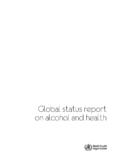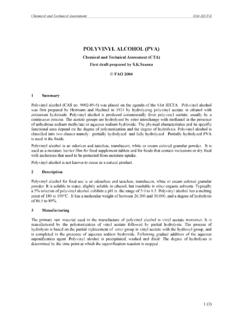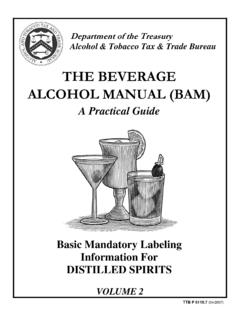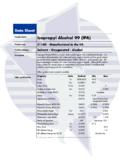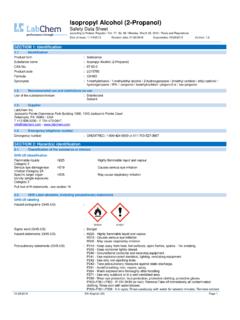Transcription of Global Status Report on Alcohol 2004
1 WHO Global Status Report on Alcohol 2004. Global Status Report on Alcohol 2004. world health organization Department of Mental health and Substance Abuse Geneva 2004. WHO Global Status Report on Alcohol 2004. WHO Library Cataloguing-in-Publication Data world health organization . Global Status Report on Alcohol 2004. 1 v. + 1 CD-ROM. CD-ROM contains country profiles. drinking - epidemiology disorders - epidemiology of illness policy literature ISBN 92 4 156272 2 (NLM classification: WM 274). world health organization 2004. All rights reserved. Publications of the world health organization can be obtained from Marketing and Dissemination, world health organization , 20 Avenue Appia, 1211 Geneva 27, Switzerland (tel: +41 22 791 2476; fax: +41 22 791 4857; email: Requests for permission to reproduce or translate WHO publications whether for sale or for noncommercial distribution should be addressed to Publications, at the above address (fax: +41 22 791 4806; email: The designations employed and the presentation of the material in this publication do not imply the expression of any opinion whatsoever on the part of the world health organization concerning the legal Status of any country, territory, city or area or of its authorities, or concerning the delimitation of its frontiers or boundaries.))
2 Dotted lines on maps represent approximate border lines for which there may not yet be full agreement. The mention of specific companies or of certain manufacturers' products does not imply that they are endorsed or recommended by the world health organization in preference to others of a similar nature that are not mentioned. Errors and omissions excepted, the names of proprietary products are distinguished by initial capital letters. The world health organization does not warrant that the information contained in this publication is complete and correct and shall not be liable for any damages incurred as a result of its use. Printed in Singapore. WHO Global Status Report on Alcohol 2004. Foreword This volume is the culmination of three years of dedicated collaborative work of the WHO. Department of Mental health and Substance Abuse and a WHO Collaborating Centre, the Swiss Institute for the Prevention of Alcohol and Drug Problems in Lausanne, Switzerland.
3 It is an overview of the available data on Alcohol consumption and drinking patterns worldwide. WHO has been actively involved in documenting the Global , regional and national dimensions of Alcohol consumption since the start of the Global Alcohol Database in 1996. Out of the earlier work came the Global Status Report on Alcohol (1999), the Global Status Report on Alcohol and Young People (2001) and the recently published Global Status Report : Alcohol Policy (2004). This publication follows the same tradition of the first Global Status Report five years ago, but it represents a complete update of the information. It gives valuable new perspectives on the recent Status of health and social consequences of Alcohol use and levels and patterns of Alcohol consumption worldwide. A clear focus of this publication has been on developing countries, those long-neglected areas where Alcohol problems are likely to increase at an alarming rate in the future.
4 It tries through objective analysis to provide in a comprehensive and readily accessible way all the accumulated scientific information and knowledge on issues pertinent to Alcohol consumption at Global , regional and national levels. However, it is clear that many gaps remain to be filled for a comprehensive picture of the Global situation with Alcohol use and its health consequences. For example, for many countries the data is very limited, and the Alcohol per capita consumption estimates are clearly of varying quality. I hope that recognition of the limitations of available data will encourage WHO Member States and international organizations to work closely with WHO in improving data collection and reporting. I sincerely recommend this as a reference source for a wide audience of policy-makers, teachers, students, scientists and all those interested in Alcohol issues.
5 Catherine Le Gal s-Camus Assistant Director-General Noncommunicable Diseases and Mental health WHO Global Status Report on Alcohol 2004. Acknowledgements The world health organization (WHO) gratefully acknowledges the assistance of focal points in the WHO Member States who provided data and information for the country profiles and also feedback to our earlier drafts. WHO also wishes to acknowledge the generous financial support of the Swiss Federal Office of Public health , which made this Report possible. This document was prepared by Nina Rehn who was responsible for the overall management of the project that was initiated under the direction and supervision of Maristela Monteiro and completed under the direction and supervision of Vladimir Poznyak of the WHO. Management of Substance Abuse team who also provided invaluable input.
6 Kelvin Chuan Heng Khow, Management of Substance Abuse, WHO, is the principal author of the country profiles. Technical assistance in statistical analysis, production of graphs, graphic design and layout was provided by Momcilo Orlovic of the Management of Substance Abuse team in WHO. The Global overviews were a collaborative effort of Gerhard Gmel, Swiss Institute for the Prevention of Alcohol and Drug Problems, Kelvin Chuan Heng Khow and Nina Rehn, Management of Substance Abuse. Laurent Emery and Matthias Wicki at the Swiss Institute for the Prevention of Alcohol and Drug Problems assisted with different sections of the profiles and the project as a whole. Thanks are also due to Isidore Obot of the Management of Substance Abuse team, Maria Elena Medina-Mora, Instituto Nacional de Psiquiatr a Ram n de la Fuente, Mexico, Moira Plant, University of the West of England, Bristol, United Kingdom, and Robin Room, Centre for Social Research on Alcohol and Drugs, Stockholm, who provided useful comments on the draft of the document.
7 Heidemarie Vaucher, Elisabeth Grisel and Edith Bacher, Swiss Institute for the Prevention of Alcohol and Drug Problems, and Myl ne Schreiber and Tess Narciso, Management of Substance Abuse, WHO, all provided much needed secretarial and editorial assistance. The project leading to this Report was implemented under the overall guidance and supervision of Benedetto Saraceno, Director of the WHO Department of Mental health and Substance Abuse. WHO Global Status Report on Alcohol 2004. Contents Part I. Introduction 1. Data sources and methods 3. Global overviews Alcohol consumption and beverage preferences 9. Unrecorded Alcohol consumption 15. Traditional or local alcoholic beverages 18. Drinking patterns 22. Consequences of Alcohol use health effects and Global burden of disease 35. Social problems associated with Alcohol use 59. Economic and social costs of Alcohol use 65.
8 Conclusion 67. References 68. Part II. Country profiles (on CD-ROM). WHO African Region WHO Region of the Americas WHO South-East Asia Region WHO European Region WHO Eastern Mediterranean Region WHO Western Pacific Region WHO Global Status Report on Alcohol 2004. WHO Global Status Report on Alcohol 2004. Introduction The world health organization (WHO) estimates that there are about 2 billion people worldwide who consume alcoholic beverages and million with diagnosable Alcohol use disorders. From a public health perspective, the Global burden related to Alcohol consumption, both in terms of morbidity and mortality, is considerable in most parts of the world . Alcohol consumption has health and social consequences via intoxication (drunkenness), Alcohol dependence, and other biochemical effects of Alcohol . In addition to chronic diseases that may affect drinkers after many years of heavy use, Alcohol contributes to traumatic outcomes that kill or disable at a relatively young age, resulting in the loss of many years of life due to death or disability.
9 There is increasing evidence that besides volume of Alcohol , the pattern of the drinking is relevant for the health outcomes. Overall there is a causal relationship between Alcohol consumption and more than 60 types of disease and injury. Alcohol is estimated to cause about 20 30% of oesophageal cancer, liver cancer, cirrhosis of the liver, homicide, epileptic seizures, and motor vehicle accidents worldwide (WHO, 2002). Alcohol causes million deaths ( of total) and a loss of million (4% of total) of Disability-Adjusted Life Years (DALY) (WHO, 2002). Unintentional injuries alone account for about one third of the million deaths, while neuro-psychiatric conditions account for close to 40% of the million DALYs. The burden is not equally distributed among the countries. Alcohol consumption is the leading risk factor for disease burden in low mortality developing countries and the third largest risk factor in developed countries.
10 In Europe alone, Alcohol consumption was responsible for over 55 000 deaths among young people aged 15 29. years in 1999 (Rehm & Eschmann, 2002). Given Alcohol 's significance in world health , WHO has, since 1996, been developing a database, the Global Alcohol Database, to provide a standardized reference source of information for Global epidemiological surveillance of Alcohol use and its related problems. The database is the world 's largest single source that documents Global patterns of Alcohol use, health consequences and national policy responses, by country. This monitoring system and database enables WHO to disseminate data and information on trends in Alcohol consumption, drinking patterns and Alcohol -related mortality, including details of policy responses in countries. The aim of the project is to provide up-to-date and comparative data regarding the Status of Alcohol consumption and Alcohol problems.










